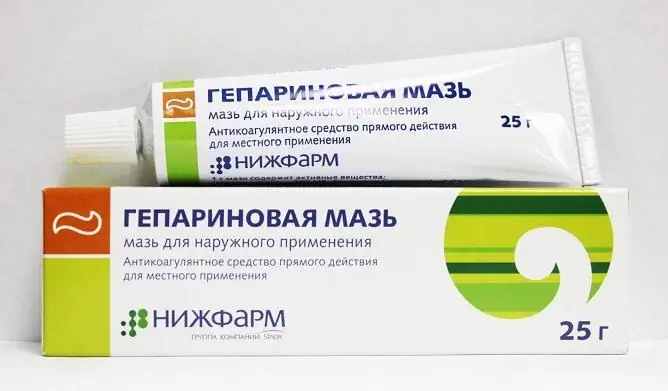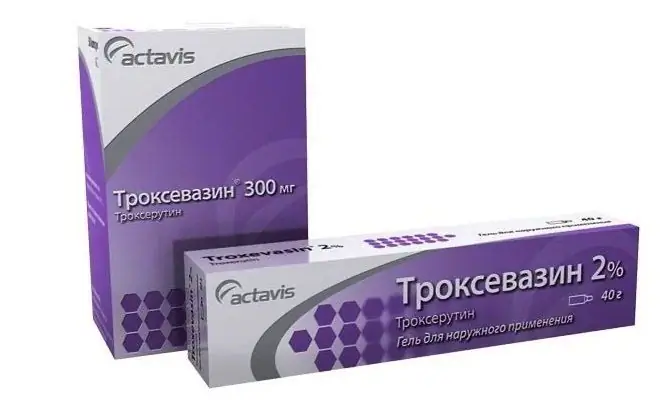Nifedipine
Nifedipine: instructions for use and reviews
- 1. Release form and composition
- 2. Pharmacological properties
- 3. Indications for use
- 4. Contraindications
- 5. Method of application and dosage
- 6. Side effects
- 7. Overdose
- 8. Special instructions
- 9. Application during pregnancy and lactation
- 10. Use in childhood
- 11. In case of impaired renal function
- 12. For violations of liver function
- 13. Use in the elderly
- 14. Drug interactions
- 15. Analogs
- 16. Terms and conditions of storage
- 17. Terms of dispensing from pharmacies
- 18. Reviews
- 19. Price in pharmacies
Latin name: Nifedipine
ATX code: C08CA05
Active ingredient: nifedipine (nifedipinum)
Producer: OOO Ozon (Russia), FP Obolenskoe (Russia)
Description and photo update: 2019-20-08
Prices in pharmacies: from 27 rubles.
Buy

Nifedipine is a calcium channel blocker.
Release form and composition
Dosage form - yellow dragee (10 pcs. In blisters, in a cardboard box 5 blisters).
Active ingredient: nifedipine, in 1 tablet - 10 mg.
Excipients: wheat starch, gelatin, magnesium stearate, lactose, microcrystalline cellulose PH101, talc.
Shell composition: isopropanol, glycerol, carmellose 7MF, acetone, arlacel 186, purified water, ethyl cellulose N22, titanium dioxide, povidone K30, sugar, ethanol 96%, macrogol 6000, talc, polysorbate 20, colloidal silicon dioxide, Eurolake Quinoline Yellow 21 (E104) and Eurolake Sunset Yellow 22 (E110).
Pharmacological properties
Pharmacodynamics
Nifedipine is a selective blocker of slow calcium channels, belongs to derivatives of 1,4-dihydropyridine. The drug has antianginal, hypotensive and vasodilating effects. It reduces the flow of calcium ions into the smooth muscle cells of the peripheral and coronary arteries, as well as into the cardiomyocytes. In high doses, nifedipine inhibits the release of calcium ions from the depot inside the cells. It reduces the number of functioning calcium channels without affecting the time of their recovery, inactivation and activation.
Nifedipine uncouples the processes of contraction and excitation in the smooth muscle of blood vessels, mediated by calmodulin, and in the heart muscle, mediated by troponin and tropomyosin. In therapeutic doses, the drug normalizes the transport of calcium ions through the membrane, which is disturbed in some pathological conditions, for example, arterial hypertension.
Nifedipine does not affect venous tone. It reduces spasm, dilates peripheral and coronary vessels (mainly arterial), lowers blood pressure and total peripheral vascular resistance, reduces myocardial tone, afterload and heart muscle oxygen demand, prolongs diastolic relaxation of the left ventricle. Under its influence, coronary blood flow increases, blood supply to the ischemic zones of the myocardium improves, and the functioning of collaterals is activated. Almost does not affect the atrioventricular and sinoatrial nodes and has no antiarrhythmic effect. Strengthens blood flow in the kidneys, causes a moderate excretion of sodium in the urine.
The clinical effect occurs in 20 minutes and lasts from 4 to 6 hours.
Pharmacokinetics
Nifedipine is rapidly and almost completely (92–98%) absorbed in the digestive tract. The bioavailability of the drug after oral administration ranges from 40 to 60% (taking simultaneously with food increases this indicator). Nifedipine undergoes a first pass effect through the liver. In blood plasma, the maximum concentration of the substance is 65 ng / ml and is observed after 1-3 hours. 90% bound to plasma proteins. Nifedipine crosses the placental and blood-brain barrier and is secreted in breast milk.
Completely metabolized. Metabolism occurs in the liver with the participation of isoenzymes CYP3A5, CYP3A7 and CYP3A4.
About 80% of the taken dose is excreted in the form of inactive metabolites by the kidneys and another 20% - with bile. The half-life is from 2 to 4 hours. With insufficient liver function, the total clearance decreases, the half-life is lengthened.
Nifedipine does not accumulate in the body. Chronic renal failure, peritoneal dialysis and hemodialysis do not affect pharmacokinetic parameters. Long-term use (2-3 months or more) leads to the development of drug tolerance. Plasmapheresis can accelerate elimination.
Indications for use
- Rest and exertion angina (including variant angina) with coronary heart disease;
- Arterial hypertension (as a monotherapy or in combination with other antihypertensive drugs).
Contraindications
- Cardiogenic shock, collapse;
- Sick sinus syndrome;
- Decompensated heart failure;
- Severe aortic / mitral stenosis;
- Arterial hypotension with systolic blood pressure below 90 mm Hg;
- Idiopathic hypertrophic subaortic stenosis;
- Tachycardia;
- Period 4 weeks after acute myocardial infarction;
- Age under 18;
- Hypersensitivity to the drug or other dihydropyridine derivatives.
Also, Nifedipine is contraindicated during pregnancy and lactation.
Due to the risk of complications, the drug should be used with caution in the following cases:
- Diabetes;
- Severe disorders of cerebral circulation;
- Severe renal / liver dysfunction;
- Chronic heart failure;
- Malignant arterial hypertension.
Caution requires the use of the drug by patients on hemodialysis.
Instructions for the use of Nifedipine: method and dosage
Nifedipine is administered orally by swallowing the tablets whole and drinking plenty of fluids during or after meals.
Doses are set individually, depending on the severity of the disease and the patient's response to the drug.
At the beginning of treatment, 1 tablet is prescribed 2-3 times a day, if necessary, the dose is increased to 2 tablets 1-2 times a day.
The maximum allowable daily dose is 40 mg of nifedipine (4 tablets).
A dose reduction is required for the elderly, patients with impaired liver function, severe cerebrovascular accidents, and patients receiving combination therapy (antihypertensive or antianginal).
Side effects
- Cardiovascular system: feeling of heat, facial flushing, peripheral edema (ankles, feet, legs), tachycardia, syncope, excessive decrease in blood pressure, heart failure; in some cases, especially at the beginning of treatment - the appearance of angina attacks, requiring discontinuation of the drug;
- Central nervous system: increased fatigue, drowsiness, dizziness, headache; with prolonged use in high doses - tremor, paresthesia of the extremities;
- Gastrointestinal tract, liver: dyspeptic disorders; with long-term treatment - liver dysfunction (increased activity of hepatic transaminases, intrahepatic cholestasis);
- Musculoskeletal system: myalgia, arthritis;
- Urinary system: increased daily urine output, in patients with renal failure - deterioration of renal function;
- Hematopoietic organs: thrombocytopenia, leukopenia, thrombocytopenic purpura, anemia;
- Allergic reactions: exanthema, urticaria, pruritus, autoimmune hepatitis;
- Others: gingival hyperplasia, hyperglycemia, changes in visual perception, flushing of the skin of the face, in the elderly - gynecomastia (completely disappears after drug withdrawal).
Overdose
With an overdose of Nifedipine, a headache appears, arrhythmia and bradycardia develop, the activity of the sinus node is inhibited, blood pressure decreases, the skin of the face becomes red.
As first aid, gastric lavage and intake of activated charcoal are recommended. The ongoing symptomatic therapy is aimed at stabilizing the work of the cardiovascular system. The antidote of Nifedipine is calcium. Requires slow intravenous administration of calcium gluconate or 10% calcium chloride at a dose of 0.2 ml / kg (total not more than 10 ml) for 5 minutes. If the effect is not achieved, it is possible to conduct a repeated infusion under the control of serum calcium concentration. The resumption of symptoms of poisoning is an indication for continuous infusion at a rate of 0.2 ml / kg / h, but not more than 10 ml / h.
If the blood pressure is severely lowered, the patient is given intravenous dopamine or dobutamine. If cardiac conduction is impaired, administration of isoprenaline, atropine or the establishment of a pacemaker (artificial pacemaker) is indicated. Developing heart failure should be compensated for by intravenous administration of strophanthin. Catecholamines are allowed to be used only in case of life-threatening circulatory failure. It is advisable to control the level of electrolytes (calcium, potassium) and blood glucose.
Hemodialysis is ineffective.
special instructions
In case of abrupt discontinuation of treatment, there is a risk of withdrawal syndrome, so the dose should be reduced gradually.
During treatment with Nifedipine, it is necessary to refrain from drinking alcoholic beverages, driving vehicles and performing potentially hazardous types of work that require speed of psychophysical reactions and increased concentration of attention.
Influence on the ability to drive vehicles and complex mechanisms
During treatment with Nifedipine, one should refrain from performing potentially hazardous work that requires a high concentration of attention and a quick psychomotor reaction.
Application during pregnancy and lactation
According to the instructions, Nifedipine is contraindicated during pregnancy and breastfeeding.
Pediatric use
Nifedipine should not be used in children and adolescents under 18 years of age, since the safety and efficacy of the drug in this age group has not been established.
With impaired renal function
Nifedipine should be used with caution in patients with severe renal impairment.
For violations of liver function
Nifedipine should be used with caution in patients with severe hepatic impairment.
Use in the elderly
For elderly patients, the drug is prescribed in reduced doses.
Drug interactions
- Other antihypertensive drugs, diuretics, tricyclic antidepressants, ranitidine, cimetidine: increased severity of lowering blood pressure;
- Nitrates: increased tachycardia and hypotensive action of nifedipine;
- Beta-blockers: the risk of a pronounced decrease in blood pressure, in some cases - worsening of heart failure (such a combination treatment should be carried out under close medical supervision);
- Quinidine: decrease in its concentration in blood plasma;
- Theophylline, digoxin: an increase in their concentration in blood plasma;
- Rifampicin: acceleration of metabolism and, as a result, weakening of the action of nifedipine.
Analogs
Analogs of Nifedipine are: Cordaflex, Cordipin CL, Cordipin Retard, Nifecard CL.
Terms and conditions of storage
Store at temperatures up to 25 ºC, protected from light and moisture, out of reach of children.
The shelf life is 3 years.
Terms of dispensing from pharmacies
Dispensed by prescription.
Reviews about Nifedipine
According to reviews, Nifedipine is an inexpensive, affordable and effective treatment for high blood pressure (including hypertensive crisis) and ischemia. However, some patients note that the drug lowers the upper (systolic) pressure and practically does not affect the lower (diastolic) pressure. The disadvantages of the drug include a large number of contraindications and a whole list of side effects that may occur during treatment. Most often, patients complain of heartburn, headache, flushing and drowsiness.
Price for Nifedipine in pharmacies
The price of Nifedipine in 10 mg tablets (50 pieces per package) is 30-50 rubles.
Nifedipine: prices in online pharmacies
|
Drug name Price Pharmacy |
|
Nifedipine 10 mg film-coated tablets 50 pcs. RUB 27 Buy |
|
Nifedipine 10 mg tablets 50 pcs. RUB 29 Buy |
|
Nifedipine tablets p.p. 10mg 50 pcs. RUB 39 Buy |

Anna Kozlova Medical journalist About the author
Education: Rostov State Medical University, specialty "General Medicine".
Information about the drug is generalized, provided for informational purposes only and does not replace the official instructions. Self-medication is hazardous to health!







